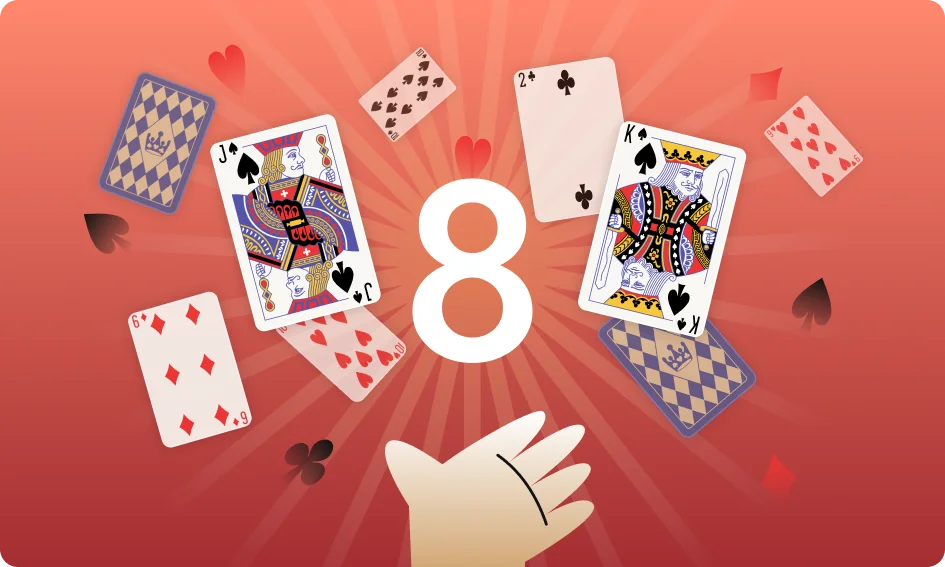If you’re like me, then your first time discovering the wonderful game of Solitaire was a treat. It made me truly appreciate how a game involving just me and my deck of cards can be both refreshing and challenging. Since then, I’ve consistently spent at least one hour a day improving my Solitaire skills.
But, there comes a time when your go-to Solitaire variant can get somewhat tedious. If you find yourself at this point, then you should know that there’s a whole universe of Solitaire variants waiting to be discovered. This variety ensures that players do not get bored of playing the same game. So, instead of sticking to your monotonous routine, try embarking on an exciting journey through the diverse Solitaire landscape.
Klondike Solitaire
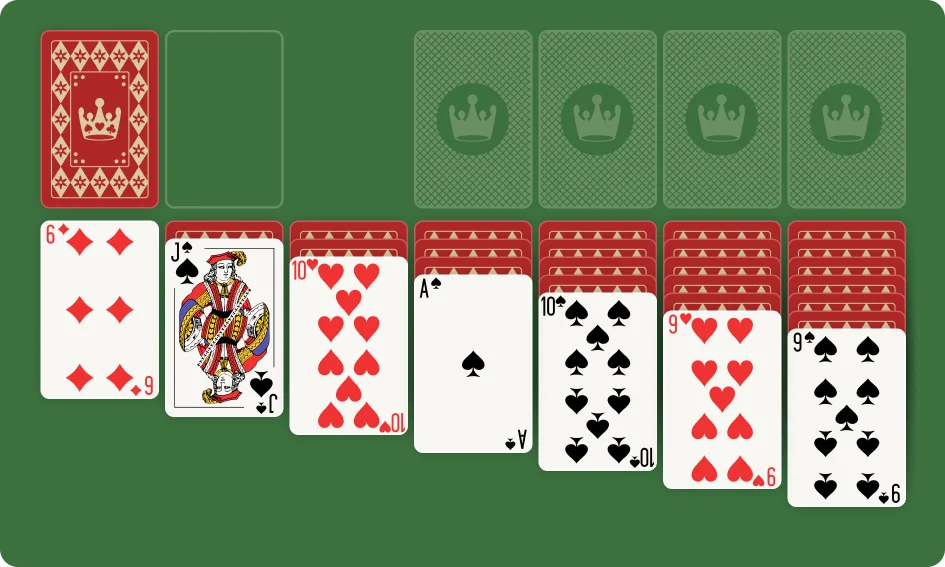
With roots going back to the Gold Rush era, Klondike Solitaire has captivated players for generations. When thinking of Solitaire, most people will likely think of this variant (also known as the ‘classic’ version). This renowned Solitaire game has seven tableau piles and is one of the easier options for new players.
Objective
The main objective in Klondike Solitaire is to build four foundation piles in ascending order, each starting with an Ace and ending with a King. The game starts with seven piles of cards, with the top one face-up. You can draw from the remaining cards that form the stock. Your goal is to move cards between the tableau and foundation piles to arrange them and form four piles. This completes the game.
How to Play
- The four ascending suit piles you create are known as “the foundations”.
- The seven piles on the table are referred to as “the tableau”. Each pile in the tableau has its top card exposed. You can place cards that are one rank lower and the opposite color on top of these piles.
- You can also transfer multiple cards in one move as long as the first card in the sequence conforms to the aforementioned rule.
- The remaining cards are referred to as “the stock”. You can move the top three cards from the stock at any point to what is known as “the waste pile”. The topmost card in the waste pile is playable; so, you can utilize it as a tableau card.
- When the stock is depleted, you can roll over the waste pile and reuse it as fresh stock.
- If you get trapped with no more moves, then the game is lost.
Pyramid Solitaire
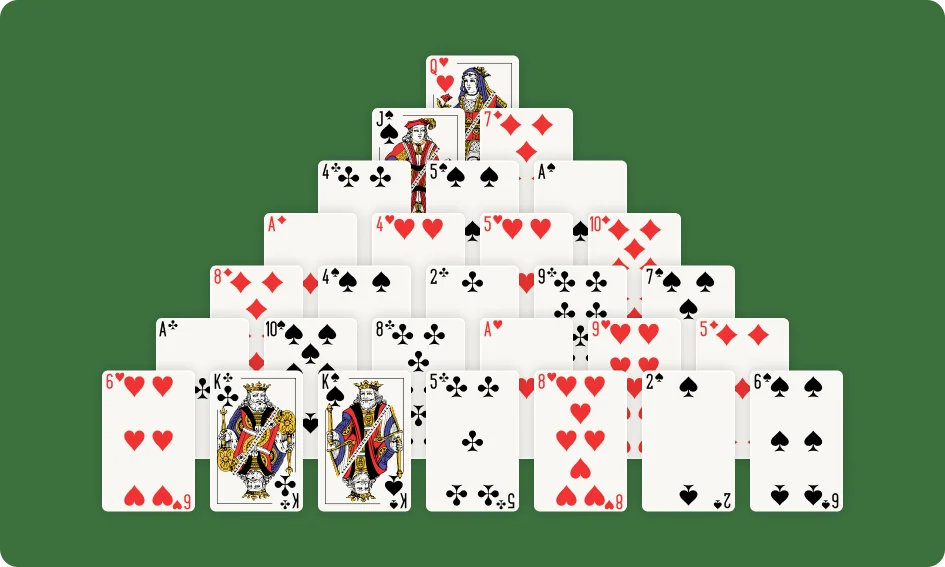
Everyone likes a little challenge now and then, and Pyramid Solitaire will definitely fulfill this need. This captivating variant of the classic card game requires you to dismantle a pyramid-shaped tableau of cards. The game requires strategic thinking to uncover and match pairs of cards to clear the pyramid. For me, it’s a relatively light variant, one that I like to play when I’m exhausted after a long day.
Objective
The primary goal in Pyramid Solitaire is to clear all cards from the pyramid by pairing exposed cards that have a total value of 13. As cards are paired and removed, you gradually expose additional cards in the pyramid. This creates new opportunities for matches.
How to Play
- Start by dealing a pyramid of cards with each row overlapping the one above it. The pyramid typically consists of 28 cards.
- Look for pairs of cards in the pyramid that have a combined value of 13 but are not overlapped by another card. For example, a Six can be paired with a Seven (if neither are obscured).
- Remove the pairs of cards that add up to 13 from the pyramid. This will help you make the layout less chaotic.
- Kings are valued at 13 and can be removed by themselves (when face-up and uncovered). If a card can’t be paired, then you can discard it into a separate discard pile.
- You win the game when you’ve successfully removed or paired all the cards in the pyramid.
FreeCell Solitaire
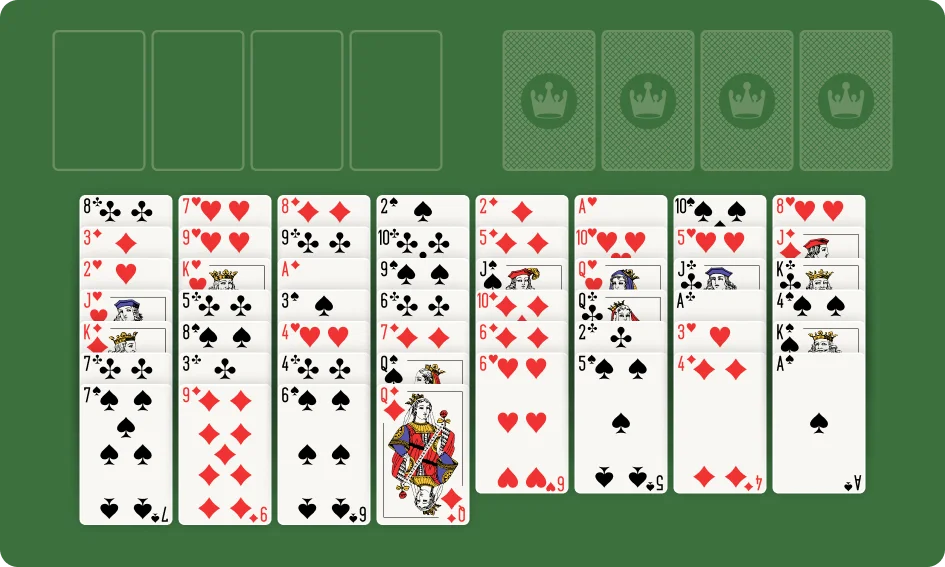
Invented by Paul Alfie in the 1970s, FreeCell is one of the most popular Solitaire variants. The game blends strategy with the thrill of winning, ensuring that you’re suitably entertained. Unlike traditional Solitaire games, FreeCell allows you to move cards freely within the tableau. This provides you with more opportunities to win the game.
Objective
The goal in the game is to create four suit-specific foundation piles in ascending sequences. You must start with Aces and then build up to Kings, just like the classic version. The game also features four cells to hold cards, which gives you some flexibility when building the foundation piles.
How to Play
- As with any card game, begin by shuffling the cards well.
- You play the game by moving cards from one column to another (just like the classic version). However, FreeCell allows you to hold cards that you need to move out of the way to find playable cards underneath.
- Remember that free cells can only hold one card at a time.
Canfield Solitaire
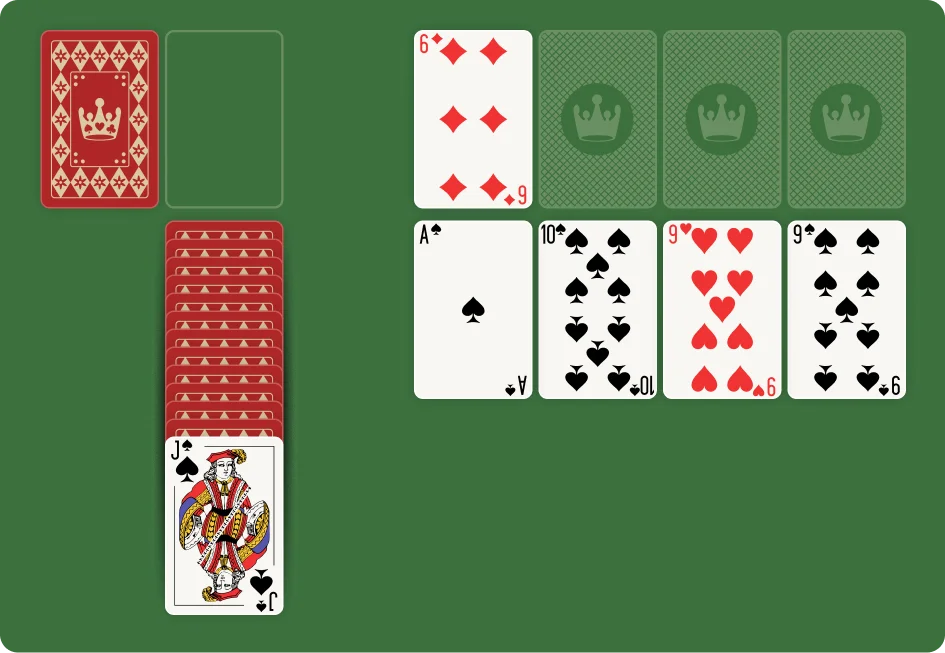
Named after casino owner Richard Canfield, Canfield Solitaire became famous due to its similarity to Klondike. This solo-player game is known for its unique gameplay mechanics and distinctive layout. It might be challenging, but with a blend of luck and skill, the game provides an engaging and rewarding card-playing experience.
Objective
Like most Solitaire variants, Canfield Solitaire requires you to move all cards to the foundation piles (sorted in ascending order from Ace to King). The game starts with a reserve pile, which contains 13 cards, the first one being face-up. The objective is to make four foundation piles, one for each suit.
How to Play
- Canfield is so intriguing because its rules are more strict than those in traditional Solitaire. You must place cards in ascending order on the foundation piles. Let’s say that you play a Jack as the first card on the foundation pile. You must then use the following sequence for the four foundation piles: J, Q, K, A, 2, 3, 4, 5, 6, 7, 8, 9, 10.
- Any slot left empty on the tableau should be filled with the top card from the waste pile or reserve pile. You can, though, choose when to do this.
- When playing from the draw deck, you can flip up three cards at a time. Only the top card of these flipped-up cards can be played.
- You can go through the draw deck as many times as you need. You can also move bundles of cards together (if they are in the correct sequence).
Golf Solitaire
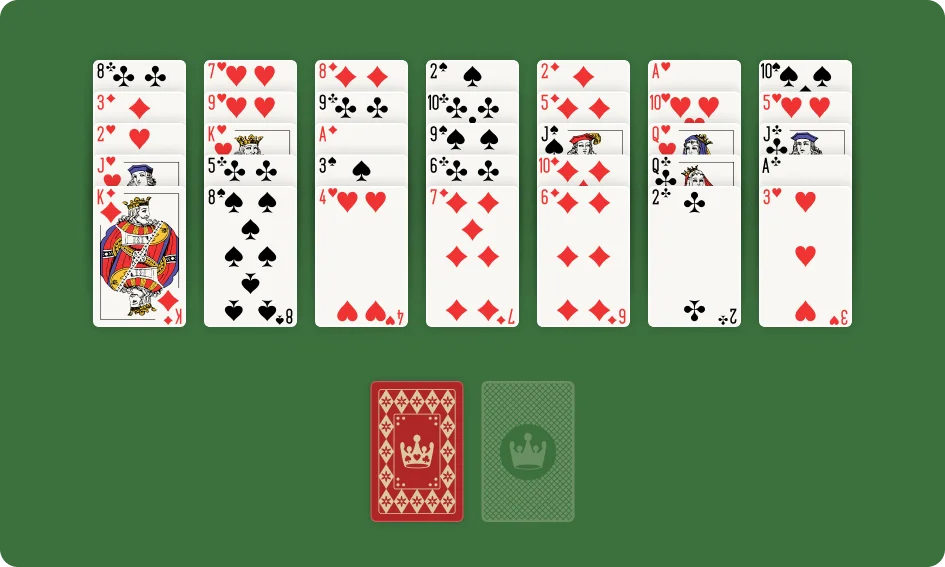
Combining Solitaire with elements of golf, this variant offers a unique twist on the classic Solitaire experience. With its unorthodox layout, Golf Solitaire provides players with an engaging challenge, one that tends to keep them coming back for more. Whether you’re a seasoned Solitaire enthusiast or a newbie, this variant promises hours of entertainment.
Objective
In Golf Solitaire, the main goal is to transfer all cards from the seven columns to the reserve pile. You can transfer cards that are either one rank higher or lower than the top card in the pile. You win the game when all cards from the seven columns have been transferred to the reserve pile.
How to Play
- For the setup, the seven columns contain five cards each. Each new row of cards overlaps the previous one. The top card from the remaining deck is placed face-up to start what’s called “the talon pile” or “reserve pile”.
- Cards can be moved from the tableau to the reserve if they are one rank higher or lower than the topmost card in the reserve pile. At the start, the reserve pile is empty, so any card can be played at that point.
- Aces and Kings are considered consecutive, which allows you to place an Ace on a King or a King on an Ace.
- You should clear the face-down cards in the tableau to reveal new playable cards and create opportunities for building sequences.
- Once you’ve removed all the cards from the tableau, you win the game.
- If you reach a point where no more moves can be played, then you can flip over the top card from the remaining talon pile. Play then resumes.
Yukon Solitaire
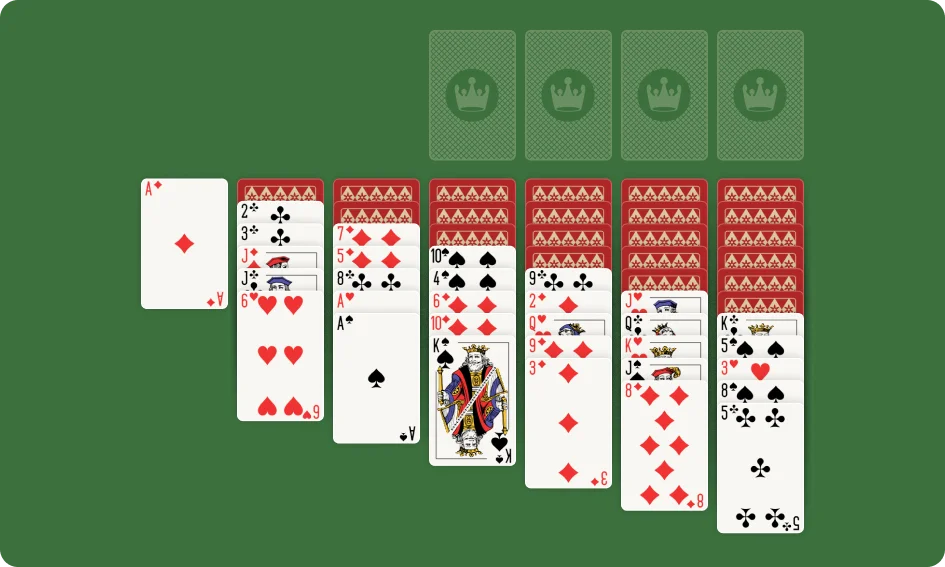
Yukon Solitaire requires players to arrange all cards in the tableau into four foundations, starting with an Ace and ending with a King. The game might look like Klondike. This was my first impression. But, its rules and regulations are quite different from the classic version.
Objective
The ultimate goal in Yukon Solitaire is to move all cards from the tableau to their respective foundation piles. Each of these piles starts with an Ace. You must then add cards on top of the Aces in an ascending order of the same suit.
How to Play
- Make seven piles in the 28-card tableau, with the top card turned over. The first pile has one card, the second has two cards, the third has three cards, and so on. Remember that all cards are face-down except for the top one.
- Move cards to the foundations whenever possible, starting with the Aces. Each foundation is built from Ace to King.
- In Yukon Solitaire, you can utilize the ‘super move’ rule. This allows you to move cards in the tableau as long as the first card in the relevant pile is one rank lower and the opposite color (regardless of whether the remaining cards in the pile create a sequence).
- Continue moving cards between tableau columns and foundations until you’ve placed them all in the foundation or until there are no more available moves.
Spider Solitaire
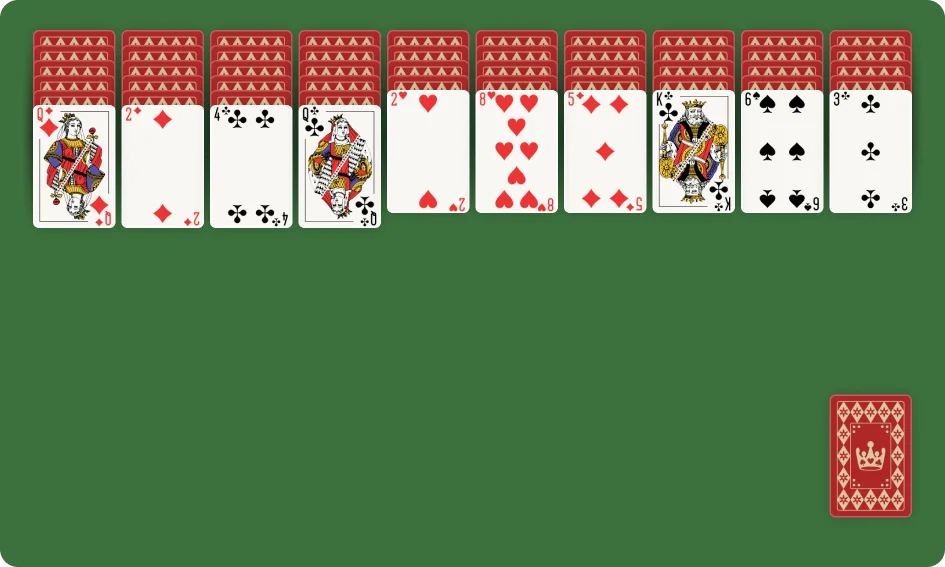
With a win rate of 1 in 3, Spider Solitaire is considered to be one of the more difficult variants. Unlike traditional Solitaire, Spider is played with two decks of cards (totaling 104). This adds an extra layer of complexity. The game is further divided into three variants: one-suit, two-suits, and four-suits, each presenting increasing levels of difficulty.
Objective
The primary aim in Spider Solitaire is to construct eight foundation piles, each starting with an Ace and ending with a King. Players must arrange cards in descending order in the tableau columns, moving cards to uncover hidden ones and form sequences.
How to Play
- On the tableau, you can move the topmost card of one pile to another pile if it is one rank lower than the card you are placing it on. You can also move multiple face-up cards in the same column as a stack (as long as the first card in the stack is one rank lower than the card you are placing it on).
- The card below is flipped face-up and becomes accessible when all the face-up cards in a pile are removed.
- Regardless of suit, a moveable unit of cards can be placed on a card that is a rank higher than the unit’s bottom card.
- Always plan your moves; this way, you won’t complicate what is already a rather confusing layout.
TriPeaks Solitaire
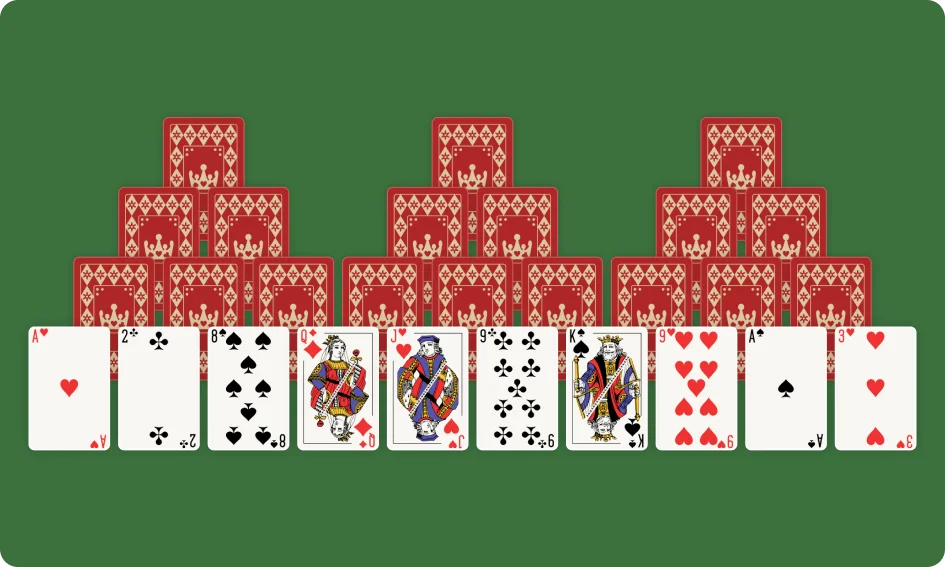
Staying true to its name, TriPeaks Solitaire has three ‘peaks’, which players aim to clear. The layout can initially appear intimidating, but I realized a few minutes into the game that it is surprisingly easy to understand. If you’re looking for that sense of achievement after overcoming a challenge, then this game is for you.
Objective
The main goal in TriPeaks Solitaire is to clear each peak in the tableau. To do so, reveal cards from the tableau that are one number higher or lower than the current card in the talon pile. Once you’ve cleared away all three peaks, you will win the game.
How to Play
- Sort three cards into different piles to make up the board. After the initial two cards are in place, put three cards below the two face-down cards. Continue doing this until three triangle peaks develop.
- Now create the final card layer, connecting the three triangles. This final row’s cards must be face-up. Set aside all of the leftover cards to create a stock.
- You can start playing now that your board has been set up. To begin the game, you must turn over a card from the stock.
- The stock cards in TriPeak Solitaire determine which cards will be played next.
- Inspect each of your three peaks closely. Look for cards in the stock that are one rank higher than the topmost card in the waste pile.
| Type of Solitaire | Main goal |
| Klondike | Build four foundation piles in an ascending order from Ace to King. |
| Pyramid | Clear the pyramids by creating pairs of cards that add up to 13. |
| FreeCell | Create four foundation piles while keeping cards in the free cells. |
| Canfield | Build four foundation piles with cards that are movable (individually or in sequences). |
| Golf | Transfer all cards from the seven columns to the reserve pile. |
| Yukon | Utilize tableau columns to build four ascending foundation piles. |
| Spider | Arrange cards into eight foundation piles in same-suit sequences. |
| TriPeaks | Clear three peaks by selecting cards that are one rank higher or lower than the top card. |
Conclusion
Playing Solitaire can both alleviate boredom and offer an entertaining way to utilize free time. So, now that you’re familiar with some of the different types of Solitaire, it is time for you to get up and start playing!

